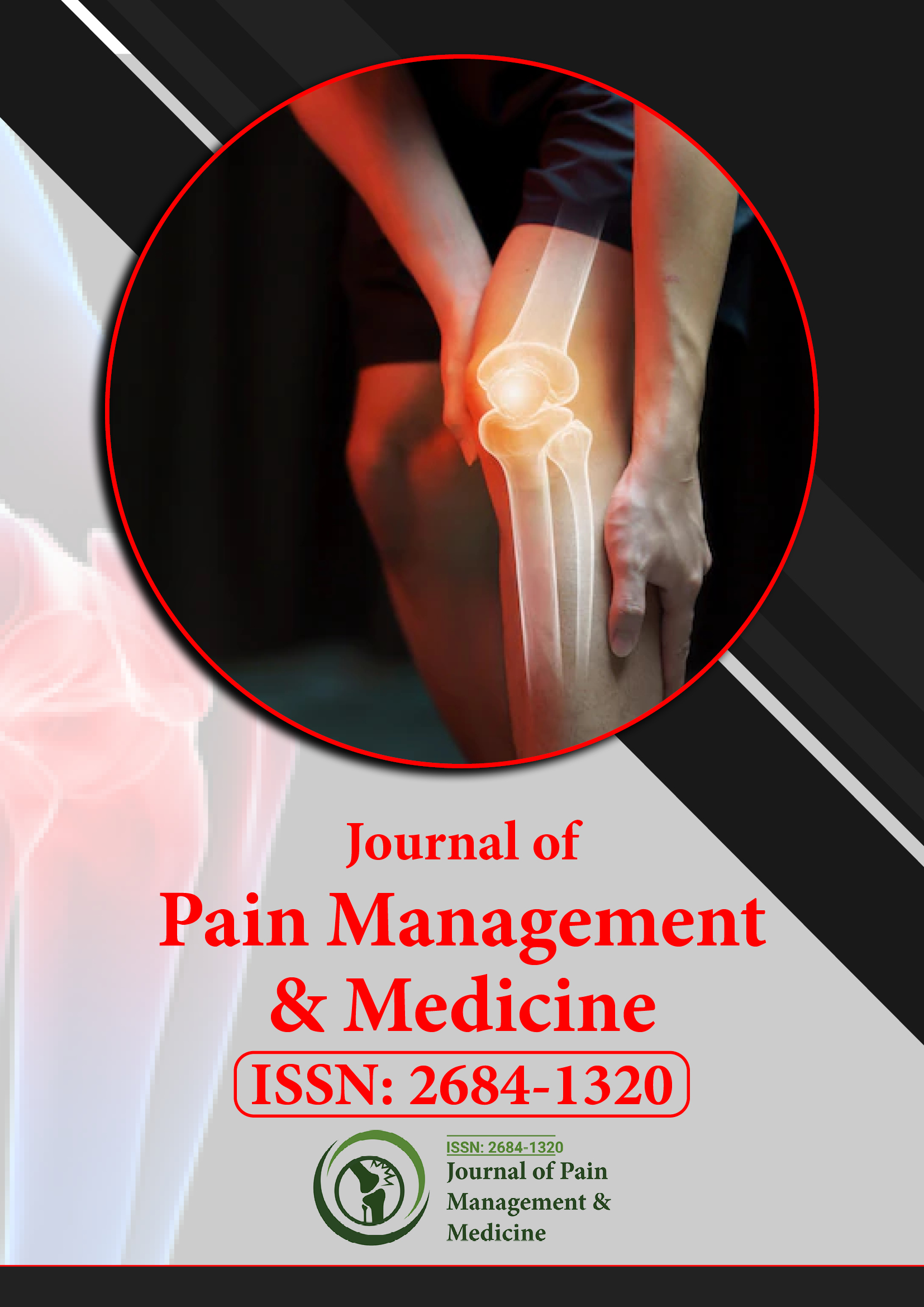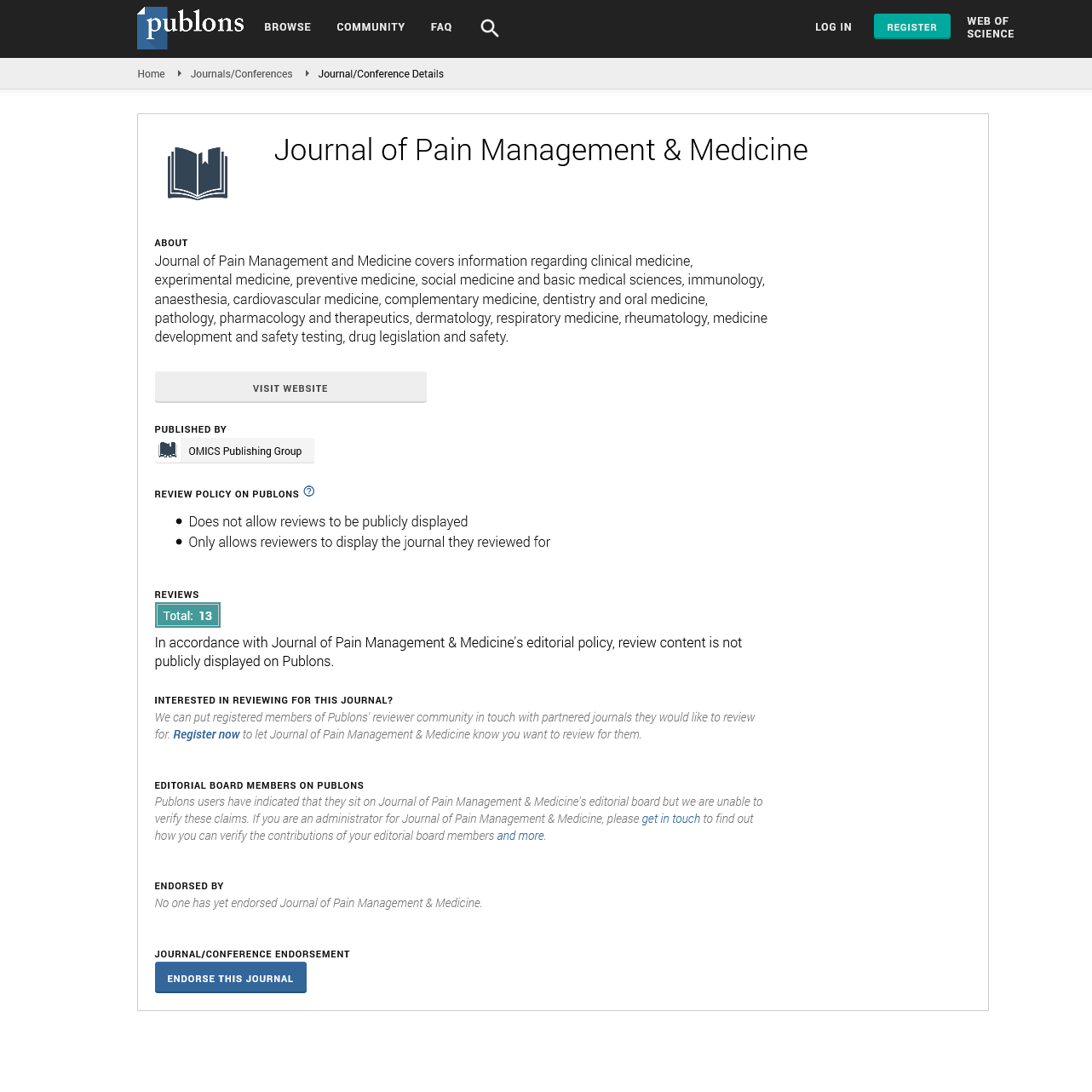Indexed In
- RefSeek
- Hamdard University
- EBSCO A-Z
- Publons
- Euro Pub
- Google Scholar
- Quality Open Access Market
Useful Links
Share This Page
Journal Flyer

Open Access Journals
- Agri and Aquaculture
- Biochemistry
- Bioinformatics & Systems Biology
- Business & Management
- Chemistry
- Clinical Sciences
- Engineering
- Food & Nutrition
- General Science
- Genetics & Molecular Biology
- Immunology & Microbiology
- Medical Sciences
- Neuroscience & Psychology
- Nursing & Health Care
- Pharmaceutical Sciences
Commentary - (2025) Volume 11, Issue 2
Peripheral Nerve Stimulation as a Beacon of Hope for Chronic Post-Amputation Pain
Fatima R. El-Masri*Received: 01-Mar-2025, Manuscript No. JPMME-25-28850; Editor assigned: 03-Mar-2025, Pre QC No. JPMME-25-28850 (PQ); Reviewed: 17-Mar-2025, QC No. JPMME-25-28850; Revised: 24-Mar-2025, Manuscript No. JPMME-25-28850 (R); Published: 31-Mar-2025, DOI: 10.35248/2684-1320.25.11.320
Description
The loss of a limb is a life-altering event, often accompanied by the persistent and debilitating Phantom Limb Pain (PLP) and Residual Limb Pain (RLP) that constitute Chronic Post-Amputation Pain (CPAP). These neuropathic pain syndromes can severely impair function, diminish quality of life, and contribute to significant psychological distress. While various pharmacological and non-pharmacological treatments have been explored, effective and long-lasting relief remains elusive for many. In this challenging landscape, Peripheral Nerve Stimulation (PNS) emerges as a promising neuromodulatory technique that warrants rigorous investigation as a potential beacon of hope for managing CPAP.
PNS involves the percutaneous or surgical placement of electrodes near specific peripheral nerves in the residual limb or the affected area, delivering mild electrical impulses to modulate nerve activity and disrupt pain signals traveling to the brain. This targeted approach offers the potential to directly address the peripheral nervous system mechanisms implicated in CPAP, offering a more localized and potentially less systemically burdensome alternative to pharmacological interventions.
The rationale for exploring PNS in CPAP is compelling. Studies have suggested that nerve damage during amputation can lead to hyperexcitability and maladaptive changes in the peripheral nervous system, contributing to the generation and maintenance of chronic pain. PNS aims to interrupt these abnormal firing patterns and restore a more balanced neural signaling, thereby reducing pain perception. Furthermore, unlike central neuromodulation techniques like spinal cord stimulation, PNS offers the advantage of targeting specific peripheral nerves implicated in the individual's pain distribution, potentially leading to more focused and effective pain relief.
Rigorous clinical trials are now crucial to definitively establish the efficacy of PNS for CPAP. These studies should employ robust methodologies, including randomized controlled designs with appropriate sham or active control groups, clearly defined primary outcomes focusing on pain intensity reduction and functional improvement, and comprehensive assessments of secondary outcomes such as medication use, sleep quality, and psychological well-being. Long-term follow-up is essential to determine the durability of pain relief and the impact of PNS on the long-term trajectory of CPAP.
Furthermore, research should focus on identifying the optimal parameters for PNS in CPAP, including the most effective electrode placement strategies, stimulation frequencies, and amplitude settings. Advanced neuroimaging techniques and sophisticated pain mapping could play a crucial role in guiding electrode placement to precisely target the implicated peripheral nerves. Personalized approaches, tailoring stimulation parameters to the individual patient's pain characteristics and response, may be key to maximizing treatment success.
Beyond pain reduction, the potential of PNS to improve functional outcomes in individuals with CPAP is a critical area of investigation. By alleviating pain, PNS may enable patients to participate more actively in rehabilitation programs, improve their prosthetic use, and enhance their overall mobility and independence. Assessing changes in functional capacity using validated outcome measures is essential to demonstrate the holistic benefits of this intervention.
The impact of PNS on the psychological burden associated with CPAP also warrants careful consideration. Chronic pain often leads to anxiety, depression, and reduced quality of life. If PNS can effectively reduce pain and improve function, it may indirectly lead to improvements in mood, sleep, and overall psychological well-being. Studies should incorporate measures of psychological distress to capture these important secondary benefits.
While PNS holds significant promise, challenges remain. Patient selection criteria need to be refined to identify individuals most likely to benefit from this intervention. Surgical implantation carries inherent risks, and the long-term reliability and maintenance of the implanted devices require careful consideration. Furthermore, the cost-effectiveness of PNS compared to other established treatments for CPAP needs to be rigorously evaluated to inform healthcare policy and access.
In conclusion, peripheral nerve stimulation represents a compelling and potentially transformative approach for the management of chronic post-amputation pain. By directly targeting the peripheral nervous system mechanisms underlying CPAP, PNS offers a unique avenue for pain relief and functional improvement. Well-designed clinical trials, coupled with research focused on optimizing treatment parameters and understanding long-term outcomes, are essential to fully elucidate the role of PNS in the comprehensive management of this debilitating condition and to offer a much-needed beacon of hope for individuals living with the persistent pain after limb loss.
Citation: El-Masri FR (2025) Peripheral Nerve Stimulation as a Beacon of Hope for Chronic Post-Amputation Pain. J Pain Manage Med. 11.320.
Copyright: © 2025 El-Masri FR. This is an open access article distributed under the terms of the Creative Commons Attribution License, which permits unrestricted use, distribution, and reproduction in any medium, provided the original author and source are credited

